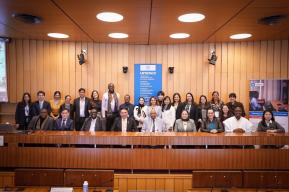News
Q&A: How UNESCO is driving digital learning and the transformation of education

On the first-ever International Day for Digital Learning - 19 March - here is what you need to know about UNESCO’s work and guidance on this essential topic for education.
Why does UNESCO consider digital innovation in education important?
We are increasingly living in a digital age, marked by a significant increase in global internet connectivity: Some 2/3 of humanity now has access to the internet. This has brought about significant changes in various aspects of life, including education systems. Digital innovation can expand access to educational opportunities to learners previously excluded - such as those with disabilities or who speak a minority language - and enhance learning quality. Open digital schools can make education systems more inclusive of learners’ diverse needs and more resilient to crises.
Furthermore, as digital technologies become ever more sophisticated and ubiquitous, digital competencies and information literacy are increasingly becoming a key component of foundational learning – without which individuals cannot participate effectively and responsibly in social, civic, and economic life.
Yet, despite promising opportunities over the past 20 years, such as enhanced accessibility for marginalized learners through advancements like connectivity, portability, open educational resources, and artificial intelligence, significant inequalities persist, particularly in connectivity, capacities and access to quality digital learning content.
UNESCO’s Global Education Monitoring Report found that only 40% of primary schools are connected to the internet. And a UNESCO global survey of over 450 schools and universities last year found that fewer than 10% of schools and universities have implemented internal policies on the use of AI. Leveraging digital technology for education requires addressing fundamental questions about its appropriate use.
The COVID-19 pandemic further underscored the importance of digital technology in education, revealing wide disparities in access and learning outcomes. Recognizing the importance of this shift, the United Nations made digital learning a priority during the 2022 Transforming Education Summit. The ‘Call to Action: Assuring and improving quality public digital learning for all’, launched at the Summit, underscores the importance of addressing the three keys to unlock the potential of digital learning: competencies, content, and connectivity. Additionally, the rapid proliferation of AI applications in education, often without clear regulations, has led to a growing demand for technical support and guidance. In response to this demand, UNESCO is working to establish regulatory frameworks, equip teachers and learners with digital skills, and collect data to inform policy in an effort to navigate this transition.
What is UNESCO’s approach to digital technologies and education?
UNESCO advocates for leveraging digital innovation to expand access to educational opportunities, enhance quality learning, and build inclusive and resilient learning systems. However, no screen can ever replace a well-qualified teacher and a well-equipped classroom. When applied properly, technology can complement and enhance the work of educators. To ensure that technology improves learning outcomes and reduces inequalities, we must actively steer the digital revolution in education, on our own terms. This was the core message of the 2024 GEM report on Technology in education: A tool on whose terms?.
UNESCO takes a humanistic approach to ensure that technology will be designed to serve people in accordance with internationally agreed human rights frameworks, and that digital technologies will be leveraged as a common good to support the achievement of Sustainable Development Goal 4 (SDG4) of the Sustainable Development Agenda, on education and to build shared futures of education beyond 2030. UNESCO’s work is guided by its 2021 UNESCO Strategy on Technological Innovation in Education.
What are UNESCO’s actions to support the transformation of education?
Specifically, UNESCO:
- Supports its Member States to design, integrate and implement effective national policies and masterplans on digital learning making sure activities on the ground meet the needs of each country and community with a special focus on disadvantaged. In addition to support on an ad hoc basis, UNESCO supports long-term projects in several countries through the Technology-enabled Open Schools for All and the ICT Transforming Education in Africa projects.
- guides international efforts to help countries understand the role that technology can play to accelerate progress towards SDG4, as envisioned in the 2015 Qingdao Declaration and the 2017 Qingdao Statement and the 2022 ReWired Declaration, which lay out key principles. Other internationally-negotiated standards include the 2019 Recommendation on Open Educational Resources and 2019 Beijing Consensus on AI and Education.
- has an observatory function of emergent technological transformations, such as a study on K-12 AI curricula: A mapping of government-endorsed AI curricula and An ed-tech tragedy? Educational technologies and school closures in the time of COVID-19. It also promote grass-rooted best practices through the UNESCO King Hamad Bin Isa Al-Khalifa Prize for the use of ICT in Education, best practices on OER, best practices in mobile learning and on AI and education.
- publishes guidance for decision-makers, teachers and students , such as Guidance for generative AI in education and research, Guidelines for ICT in education policies and masterplans, Artificial intelligence and education: guidance for policy-makers, Guidelines on the development of open educational resource policies, the UNESCO ICT Competency Framework for Teachers (ICT-CFT), K-12 AI curricula: A mapping of government-endorsed AI curricula, and the UNESCO Guidance for teachers on distance learning.
- fosters international dialogue by providing a platform for knowledge exchange to steer the digital transformation of education, addressing emerging concerns related to generative AI with ad hoc meetings such as the Ministerial Roundtable on AI and education, and convening international conferences such as Digital Learning Week and the International Forum on AI and Education.
What is the role of artificial intelligence in education and how does UNESCO support it?
Artificial intelligence (AI) has the potential to address many big challenges in education as well as bringing innovation to teaching and learning practices, such as reducing barriers to access education, automating management processes, analyzing learning patterns and optimizing learning processes with a view to improving learning outcomes. At the same time, the application of these technologies must be guided by the principles of inclusion and equity.
UNESCO supports Member States to harness the potential of AI while using a human-centred approach. It focuses on AI’s role in addressing inequalities regarding access to knowledge, research and diversity of cultural expressions to ensure it does not widen technological divides within and between countries. The rapid emergence of generative AI tools in 2023 has accelerated AI's disruptive impact on society, including the education sector, raising legal and ethical concerns such as intellectual property infringement and privacy breaches.
UNESCO has been playing a lead role in fostering dialogue and knowledge in the field of artificial intelligence and education. A number of events and publications have raised awareness of the extensive opportunities and implications of AI for education, and helped Member States begin to respond to complex challenges. In 2019, UNESCO organized the International Conference on Artificial Intelligence and Education in Beijing which resulted in the adoption of the Beijing Consensus, the first-ever document to offer recommendations on how best to harness AI technologies for SDG4.
To support its Member States in crafting strategies and policies for AI in education, and in line with the Beijing Consensus, UNESCO has developed a set of comprehensive guidance, including AI and education: guidance for policy-makers, aimed at fostering AI-ready policy-makers in education, K-12 AI curricula: a mapping of government-endorsed AI curricula, the first-ever mapping of governmental K-12 AI curricula, and more recently, the first Guidance for generative AI in education and research. In addition, UNESCO is currently formulating two sets of Frameworks of AI competencies for teachers and students.
What are Open Educational Resources?
Open Educational Resources (OERs) are teaching, learning or research materials that are freely accessible to everyone. They allow no-cost access, re-use, re-purpose, adaptation and redistribution by others. UNESCO supports their development and use, and undertakes work to develop indicators to monitor and evaluate their use and impact, facilitating the creation of national OER policies. UNESCO developed and adopted international consensuses and instruments including The Paris OER Declaration 2012 and 2019 UNESCO Recommendation on OER, as well as provides guidelines on the development of OER policies, and provides technical support for Member States to develop strategies on adopting OER.
The Organization also cooperates with partners on providing openly available and high-quality reading resources to children in the language they speak at home through the Global Digital Library and Translate a Story campaign. At the Transforming Education Summit, UNESCO and UNICEF launched Gateways to Public Digital Learning, a global, multi-partner initiative to support countries in securing equitable access to free and open digital learning content.
How does UNESCO work to ensure women and girls are better represented in digital disciplines?
Gender inequalities in access to new technologies impacts the competencies and future professional development of women and girls in digital disciplines, which also leads to gender bias in the development of AI programmes and technological tools. Indeed, women and girls are underrepresented in ICT disciplines, in the ICT sector, and in AI development with 80% of software development created by male-only teams. UNESCO leverages partnerships such as the UNESCO-Huawei Technology Enabled Open Schools for All project to help encourage girls to use technology early on at the school level, train them for the technological sector and support their studies in AI and other new technologies.
UNESCO is also supporting grassroots initiatives, providing training and mentoring for female STEM Ambassadors and facilitating awareness-raising campaigns targeted at schoolgirls as part of the project ICT Transforming Education in Africa.
What is the concept of digital open schools?
There is an urgent need to build more crisis-resilient, inclusive and future-proof education, and the transformation of schools is a critical component of this effort. Schools need to be reimagined so that they are not only more resilient in the face of physical disruption but are also more responsive to the rapidly-evolving needs of individuals, society and the world of work.
UNESCO, in cooperation with its partners, has been steering the human-centred digital transformation of school education through digital open school models with a vision to combine technology and human competencies to create a flexible, inclusive and quality learning environment while reinforcing education across physical and virtual spaces.
- More on International Day for Digital Learning
- UNESCO’s work in digital learning and the transformation of education





